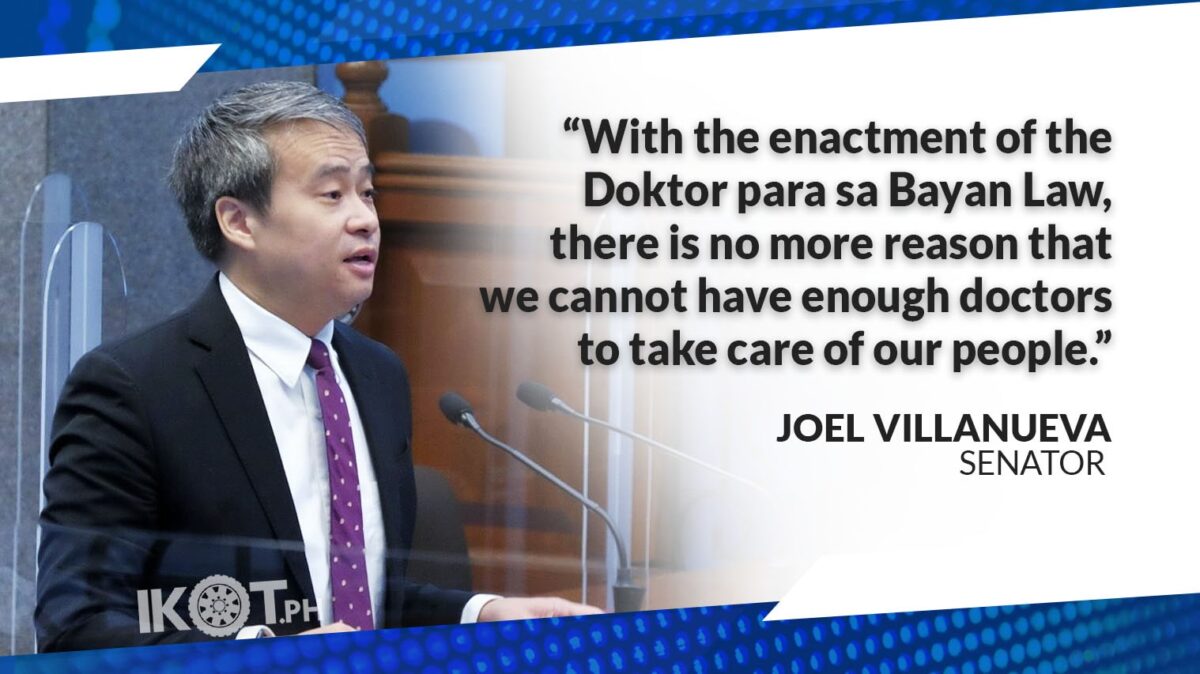The 2021 national budget has sufficient funding to support the implementation of the Doktor para sa Bayan Act, which has been signed into law recently by President Duterte, according to Senator Joel Villanueva.
Villanueva, principal sponsor and author of Republic Act No. 11509 or the Doktor para sa Bayan Act, explained that Congress allocated over P1 billion for the Commission on Higher Education (CHED) and the Department of Health (DOH) to increase more scholarship slots for aspiring doctors and provide them with their needs going to medical school.
“Their dream of becoming a doctor has a clearer path today.”
“With the enactment of the Doktor para sa Bayan Law, there is no more reason that we cannot have enough doctors to take care of our people. One of our goals in the measure is to eliminate the biggest perceived reason of our youths who aspire to become doctors. Their dream of becoming a doctor has a clearer path today through the Doktor para sa Bayan bill,” the veteran legislator said.
“Litaw na litaw po ang tinaguriang Achilles’ heel ng ating healthcare system ngayong pandemya. Kulang po ang ating mga doktor na siyang mangangalaga sa ating mga kababayan,” the seasoned lawmaker noted.
“Inaasahan po natin na sa kalaunan, dadami ang mga doktor sa mga bayan at munisipalidad, at hindi na kailangang dumayo pa ang mga maysakit sa mga malalayong lugar para mabigyan ng atensyong medikal,” the senator added.
Under this year’s national budget, both CHED and DOH were allocated some P802 million to allow them to accommodate more scholars under the medical scholarship program.
Congress also allocated P279 million for Cebu Normal University, University of Southeastern Philippines, and Western Mindanao State University which are all on track to open their own colleges of medicine this year, according to Villanueva.
CHED has also P150 million in its budget to assist other state universities and colleges intending to establish their own medicine programs, he added.
At present, Villanueva lamented that most of the country’s doctors are concentrated in urban centers like the National Capital Region where nearly 40 percent of the licensed physicians practice their profession.
In contrast, Region 4B (MIMAROPA), Region 12 (CARAGA) and the Bangsamoro Autonomous Region in Muslim Mindanao have 1 doctor for every 10,000 population in their regions.
“To meet the ideal ratio of 10 doctors for every 10,000 people prescribed by the World Health Organization in the specified regions, the government would need to multiply their efforts 10 times,” he pointed out.
“6 out of 10 Filipinos who die in the country were not able to see a doctor for treatment.’
Citing data from the Philippine Statistics Authority, Villanueva said some six out of 10 Filipinos who die in the country were not able to see a doctor for treatment.
Under the measure, the government will shoulder all expenses to send beneficiaries to medical schools, provided that they will work in the country for the same number of years they were under the scholarship program. After graduating and passing the board exam, the government is mandated to open up plantilla positions for beneficiaries in public health facilities, said Villanueva.
The law sets up a medical scholarship and return service program, which grants scholarships to deserving students aspiring to become physicians.
It seeks to encourage students to take up medicine, and help improve the country’s doctor-patient ratio, which is currently at a dismal three doctors per 10,000 populations according to health department data.
The country needs to produce over 80,000 doctors to meet the WHO-prescribed ratio of 10 doctors per 10,000 population.
He said the bill would prioritize qualified applicants from municipalities without government physicians to ensure the assignment of at least one doctor for every municipality in the country.

